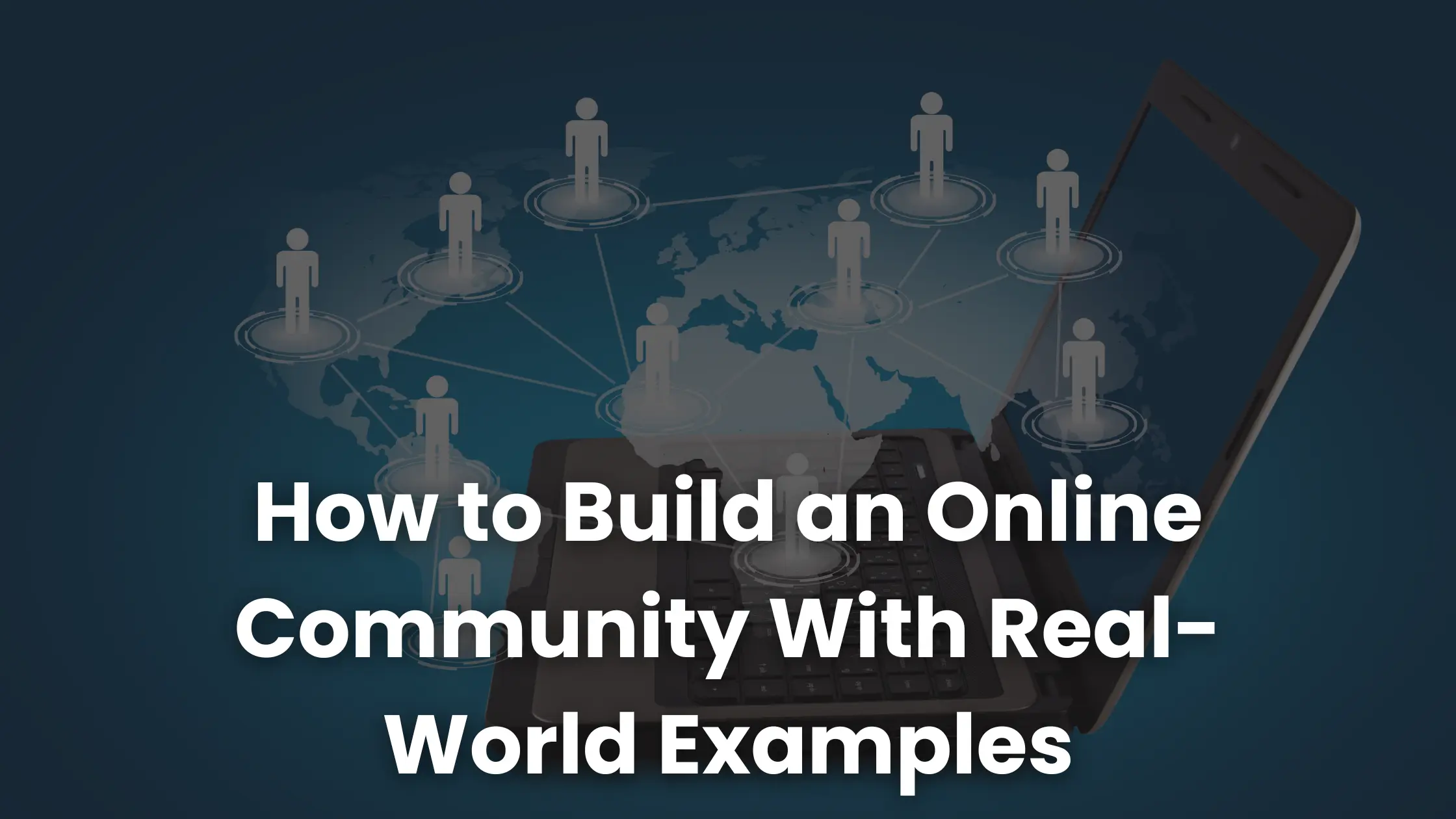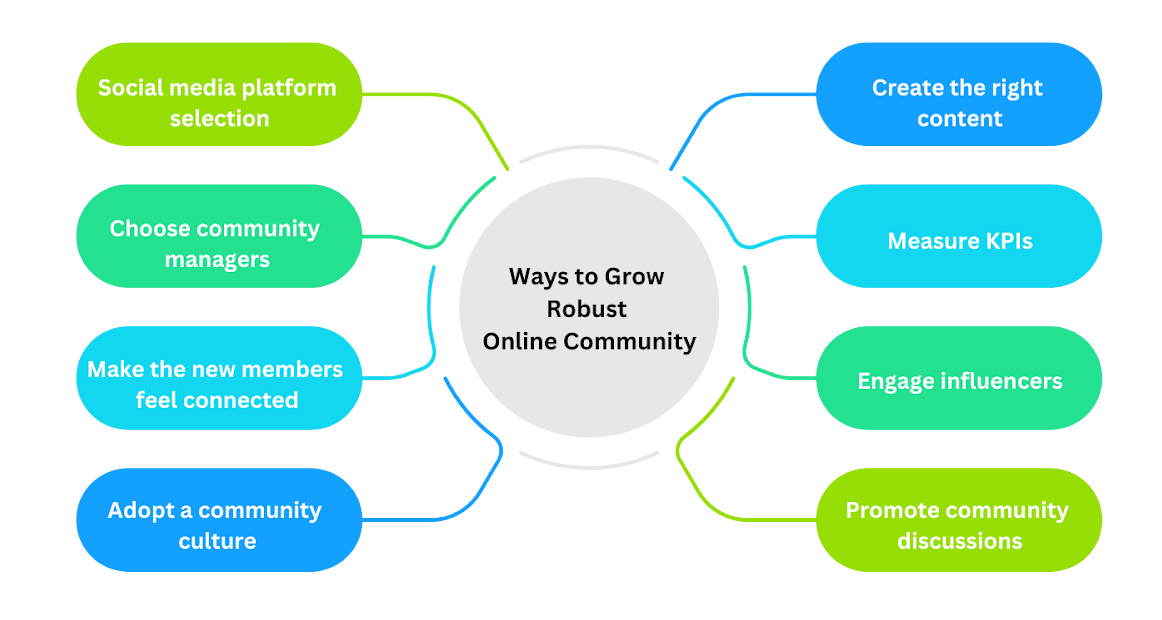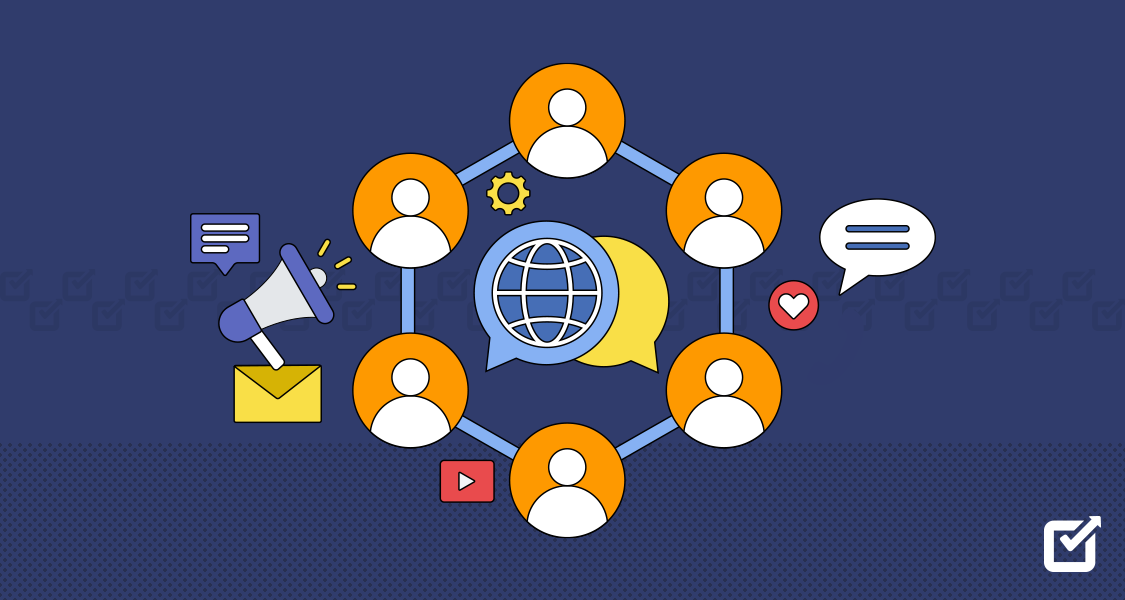How to Build an Online Community With Real-World Examples
Learn how to build an online community that boosts engagement and increases ROI with these 10 proven, actionable steps.
Learn how to build an online community that boosts engagement and increases ROI with these 10 proven, actionable steps.

Today, people are no longer satisfied with just consuming content. They want to connect, contribute, and feel like they belong. This shift in behavior is pushing businesses, creators, and brands to move beyond follower count and focus on building thriving communities.
According to the 2023 Community Industry Trends Report, 80% of the respondents reported that the community had a positive impact on the business. These numbers highlight communities as a strategic asset, providing ROI in the long run.
This guide breaks down how to build an online community that people want to join and stick with. From defining your target audience to keeping your members engaged, each step is covered in detail to help you build a space your members genuinely care about.

An online community is a virtual space where people with shared interests, goals, or challenges come together to connect, collaborate, and contribute to a common purpose. These communities exist on online platforms, like Facebook, Discord, Reddit, or specialized tools like Skool or Mighty Networks.
Unlike a typical audience that passively consumes content, members of an online community thrive on participation. They ask questions, share their experiences, offer support, and exchange ideas. This active involvement fosters connection, loyalty, and trust, creating a lasting bond.
The Community Industry Report indicates that half of the respondents believe communities are extremely successful at impacting business goals. That means if you're considering building a community, whether for your organization, employee learning, or customer engagement, now is an ideal time to take action.
Understanding how to build an online community is a strategic investment. Whether it’s an online course platform for community building or a brand-led network, the goal is the same. The aim is to create a space where people feel seen, heard, and valued. When done right, this can translate to long-term loyalty and business growth.
This step-by-step guide walks you through the essential steps in building an online community that attracts and retains members.
Before launching anything, ask yourself why. Why will it benefit you, and why should the members join? There must be some incentive on both sides of the line for your community to work. Your answers should clarify what value your space offers and what members will gain from joining it.
Once you've got the answers to these questions, it's time to identify your ideal community member. Conduct market research, send out surveys, and create personas that capture your audience's demographics, pain points, and interests. The more niche and focused your audience, the easier it is to attract the right people and tailor your content according to them.
Bonus Tip: Always remember, you're not your target audience. Validate your ideas with data from A/B testing, surveys, and face-to-face interactions, rather than relying solely on intuition.
Not every platform suits every audience. Choosing the right platform depends on your audience's needs, behavior, and preferred interaction style. There are several platform options, offering a range of features, from analytics to customization. They can be categorized into two types:
Both public and private platforms serve the same purpose, but there are a few stark differences. Public platforms offer a wider audience, but they provide limited control over the community.
These platforms, especially Facebook groups, are subject to algorithm changes, which can affect your visibility. They provide limited engagement tools, branding options, and privacy control, along with surface-level analytics that are not sufficient to run a large community.
Alternatively, private platforms offer greater control with advanced features, such as integrated CRM, customizable user profiles, and even management capabilities. They offer a more exclusive and safe environment, providing you with full ownership of your community. You also get detailed analytics and metrics on memberships and revenue.

Instead of constantly posting and spamming members with posts, focus on sparking discussions between members. Ensure your content includes a mix of blog posts, videos, infographics, and user-generated content (UGC) to keep members engaged. This is especially important if you’re creating a learning community using Coursebox to connect your employees.
You can build a content calendar and track which format gets the most traction to align the posts with your members’ preferences. The key is to consistently post mildly relevant and engaging content, instead of spending months finding perfectly relevant content.
By consistently sharing high-quality content and engaging with your audience, you can establish your credibility, leading to brand loyalty and increased engagement. A 2024 study found that while posting frequency helps you stay visible, the quality of your content is a stronger predictor of customer loyalty.
According to management expert Peter Drucker,
“What gets measured, gets managed.”
Success metrics differ for every community, depending on the purpose and goals. However, we can broadly categorize these metrics according to the community health and the impact of the community on the organization’s goals.
To assess the health of the community, measure metrics like visitors per month, number of posts per month, member growth, sentiment analysis, and churn rate. These metrics give a clear picture of how valuable your community feels to its members.
The impact of the community on business goals can be measured by customer acquisition, customer support, retention and revenue growth. In short , a well-managed community strengthens brand loyalty and delivers value, resulting in a greater return on investment.

Building something that people want is the easy part; convincing them to take notice is the real test of patience. Start by showing up. During the early stages, respond to every post, welcome every new member, and celebrate small contributions to make the members feel seen.
Ask open-ended questions and tag community members in relevant discussions to encourage peer-to-peer conversations and learning. The benefits of peer learning go beyond community engagement. It builds trust and encourages members to share their expertise. When members feel seen, they are more likely to stay engaged and advocate for the community.
Remember, your community members are as real as you. Engage with them naturally and ensure you provide value, even in casual conversations, rather than focusing on self-promotion.
You can share your story, how and why you started this community, and what you hope to build. This personal narrative helps humanize your brand and makes it easier for members to connect with you. Sprout Social reveals that 70% of consumers feel more connected to brands whose CEO or founder is active on social media. Additionally, your community can serve as a space for customer education, helping members better understand your product or services.
It is important to set boundaries early with a pinned welcome post that outlines community values, expectations, and rules regarding promotion and UGC (User-Generated Content). Make it clear what’s allowed and what’s not, so your community grows according to your rules.
Clear guidelines reduce confusion and set the tone for respectful interaction. When members know what behaviour is expected, it reduces the risk of toxicity and conflict. To maintain consistency, ensure your moderators are well-versed in the rules and ready to step up when issues arise.
Some important rules to add to the community guidelines are:
With over 5.07 billion social media users around the world, if you’re not using social media platforms to cross-promote your community, you’re missing out. Leverage these platforms to promote your community, encourage interaction, and drive traffic to build awareness and funnel the right members.
Start by identifying where your audience spends most of the time online. Use social media analytics to pinpoint the platforms that already have their attention and focus on that first.

Strong communities aren’t built for members; they are built with them. Invite members to shape the direction of the community by running polls, collecting feedback, and letting them vote on upcoming topics. You can also assign community members with leadership roles, such as community moderators or discussion hosts, to provide a sense of ownership to the members.
Keeping members involved at every stage boosts participation and builds brand loyalty, which in turn helps foster brand advocacy. Identify the most active members and offer them the position of brand advocates, along with exclusive perks such as early access to products and discounts, in return for their community promotion.
Organizing events and challenges is an excellent way to bring your community together. This could be a hashtag challenge or a small meet-and-greet.
You could also organize live interviews, monthly Zoom Q&As, themed workshops, and launch parties. These real-time interactions enable members to connect on a personal level and foster a deeper connection with one another and your brand.
Make it easy for people to join, comfortable to participate, and worthwhile even if they’re just listening. Record these events and repurpose them for your content by posting them on Instagram stories and LinkedIn posts.
Everyone loves a little exclusivity. Offering member-only perks gives your community a sense of reward and recognition. Small rewards, such as early access to products and members-only discounts, can demonstrate to members that they are valued within this community.
In addition to these perks, don’t forget to celebrate your members. Publicly recognizing their efforts by highlighting their contributions. These gestures will make them feel appreciated, which will build trust and reinforce engagement.

A thriving online community does more than gather people in one place; it drives meaningful results for your brand. Let’s take a look at the benefits of an online community and how it helps your business grow:
In a world where consumers are bombarded with ads and sponsored content, they increasingly seek trust in online communities. These communities allow authentic, peer-driven conversations that feel human and transparent. When potential members see people exchanging insights, asking questions, and sharing experiences within your community, it signals that your brand is both credible and trustworthy.
Gone are the days when engagement just meant likes and shares. Now it’s also about time, attention, and interaction. Interactive experiences, like live chats, community discussions, and UGC, drive deeper engagement than passive marketing. For example, when learning how to market an online course, most marketers recommend posting about your course on social media. However, posting about it in your community is what drives real results.
Compared to traditional advertising channels, online communities have a relatively higher ROI. This is because they lower the customer acquisition costs and dramatically increase retention. Brand advocates and reduced sales friction also contribute to a higher ROI.
As your members interact, share resources, and invite others, your reach naturally grows. Whether it’s a shared link, a helpful thread, or user-generated content, your brand gets organic exposure without spending on ads.
One of the most underrated benefits of an online community is the invaluable insights into your members' needs and preferences. Your members will tell you themselves exactly what they need, what’s working, and what’s falling short. All you need to do is listen to them intently and pick up cues from their feedback.

With the right strategy, communities can achieve a range of benefits, from reducing support tickets to building a loyal consumer base. Let's look at how some major brands are turning connection and conversation into brand growth and loyalty:
Just like building a vibrant online community for training companies, the official Zoom community platform offers a comprehensive space that offers essential information. Users can ask questions, troubleshoot issues, and share best practices. With over 300 million daily users, the forum is loaded with how-to guides, recent updates, and user-led tips. This reduces the burden on customer support, as the majority of answers can be easily found in user conversations.
LEGO Ideas is an excellent example of how brands can leverage consumer loyalty to drive growth and innovation. LEGO fans around the world are encouraged to submit original LEGO set ideas. The community votes for the best set, which is then considered for production.
Another popular community is the Sephora Beauty Insider Community, where makeup enthusiasts connect with one another. Members share their favorite makeup products, reviews, tutorials, and skincare advice in dedicated forums. What makes Sephora's community stand out is its authenticity, building immense trust and loyalty. When women see other women raving about a specific product, they are more likely to buy it, thereby increasing sales.
People join communities to connect with like-minded individuals who share common interests. The members come together in a community to discuss their interests, ask questions, or share their insights over a topic.
Online communities are formed by bringing people with similar interests together on a shared platform. You need to conduct market research and post targeted content to effectively reach your audience. Over time, with valuable content and consistent interactions, the communities grow organically.
Building an online community typically takes from a few months to a year. However, it can take several years with consistent posting and interaction for the community to grow.
Building a strong online community doesn’t happen overnight. It requires thoughtful planning, consistent engagement, and a clear understanding of your audience’s needs. From defining your brand values to consistently interacting with your members, each step plays a role in building something people want to be a part of.
Many businesses are now creating internal communities to train and connect their teams across locations. This is where Coursebox comes in. With its AI-driven course creation and built-in community features, Coursebox enables you to design courses and bring learners together in a shared space.
Ready to build a thriving community without stress? Try Coursebox and take the first step towards building something truly impactful!
